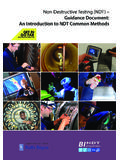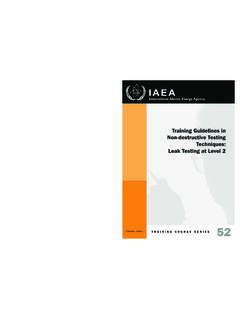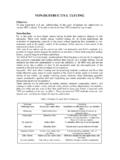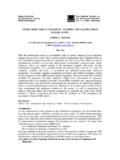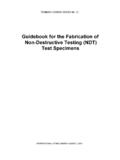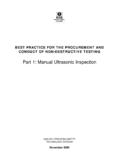Transcription of RR659 - Evaluation of the effectiveness of non …
1 Health and Safety Executive Evaluation of the effectiveness of non-destructive testing screening methods for in-service inspection Prepared by Doosan Babcock Energy Limited for the Health and Safety Executive 2009. RR659 . Research Report Health and Safety Executive Evaluation of the effectiveness of non-destructive testing screening methods for in-service inspection Fraser Hardie Doosan Babcock Energy Limited Porterfield Road Renfrew PA4 8DJ. A wide range of engineering plant is subject to periodic in-service inspection in order to ensure continued safe and economic operation. The inspections are often performed by traditional NDT methods such as routine ultrasonics, magnetic particle inspection , dye penetrant inspection , visual inspection and radiography. These can be highly sensitive but the rate of coverage is often slow, so that full coverage can be prohibitively expensive, and extensive preparation for inspection may be required (eg access for internal visual inspection , removal of insulation for external inspection etc.)
2 There are also many situations where geometry or access prevents the use of conventional inspection methods. Over recent years a wide range of advanced NDT techniques has evolved. These techniques provide large area screening of a component for significant degradation. Some of the techniques can be rapidly applied, much quicker than a more detailed, conventional inspection . Generally, the screening techniques are less sensitive than the more traditional methods. They also provide a means of inspecting areas which would otherwise be uninspectable'. Examples include long range ultrasonics, pulsed eddy current techniques and saturated low frequency eddy current techniques. There is a lack of objective information on the capability and limitations of screening techniques which is needed in order to allow judgement on their suitability for a particular application. Information is required on how to select a particular technique, what it can detect (as well as what it can miss), and what the level of confidence is in no degradation being present if none is detected.
3 The aim of this document is to provide an objective source of information on the capability and limitations of screening techniques and to provide information on their use to those involved in plant operation and maintenance. This report and the work it describes were funded by the Health and Safety Executive (HSE). Its contents, including any opinions and/or conclusions expressed, are those of the author alone and do not necessarily reflect HSE policy. HSE Books Crown copyright 2009. First published 2009. All rights reserved. No part of this publication may be reproduced, stored in a retrieval system, or transmitted in any form or by any means (electronic, mechanical, photocopying, recording or otherwise) without the prior written permission of the copyright owner. Applications for reproduction should be made in writing to: Licensing Division, Her Majesty's Stationery Office, St Clements House, 2-16 Colegate, Norwich NR3 1BQ.
4 Or by e-mail to 2. Foreword This document is aimed specifically at assisting the purchaser in the effective selection of screening techniques for in-service inspection and subsequent use and understanding of the data generated by the inspection . The screening techniques are generally specialised NDT. inspection techniques aimed at detection of corrosion in pipes and vessels This document has been written as part of the work coordinated by Doosan Babcock as part of Project GSP 236. A list of the members of the steering committee is given in Appendix 4. The HSE was a member of the steering committee and would like to thank the other members of the committee for allowing the release of commercial information to be published as a HSE document. H Bainbridge Principal Specialist Inspector Health and Safety Executive 3. CONTENTS. Foreword 3. Definitions 5. 1. introduction . 7. 2. Basis for Performing Screening. 10. 3.
5 Information Required to Select a Particular Screening Technique. 12. 4. Screening inspection Plan. 15. 5. inspection Preparation, Implementation and Reporting. 20. 6. References. 27. Appendices A1 Review of Screening Techniques for In-Service inspection A2 Table of Capabilities of Screening Techniques for In-Service inspection . A3 In-Service Screening inspection Plan. A4 GSP236 Steering Committee Members A5 Datasheets A6 Statistical Methods 4. DEFINITIONS. In the context of this document the following definitions apply. In certain cases these definitions are the same as, or are based on, those which appear in other documents such as those of the British Personnel Certification in Non-Destruction Testing (PCN) scheme. Screening Technique A loose term categorising techniques which might be less sensitive than traditional NDT methods but which may, for example, provide economic large area coverage, or are more tolerant to restrictive access, geometry or material.
6 Non-invasive inspection inspection of a vessel without having to break containment and/or not requiring vessel entry. It may be performed on-stream or off-stream. The terms non-invasive and non-intrusive are often used interchangeably. NDT Method Discipline applying a physical principle in non-destructive testing. Examples of NDT methods are: Ultrasonic examination Radiography Eddy current testing Magnetic particle testing Penetrant testing NDT Technique A specific way of applying a NDT method ( TOFD). NDT Procedure A written description of all essential parameters and precautions to be observed when applying an NDT. technique to a specific test, following an established standard, code or specification. Probability of detection Probability of detecting a defined defect type in the area (POD) covered by the inspection method. Technique efficiency A qualitative measure of POD. Coverage The proportion of the structure or region thereof under consideration that is actually subject to inspection .
7 inspection effectiveness A measure of the probability of detecting defects, taking coverage into account. Assuming a uniform defect distribution, effectiveness = POD x Coverage. Competency Capability to perform a given task on the basis of education, training, qualification and experience following objective assessment. To achieve the appropriate level of competency might require a team. 5. Qualification Evidence of training, professional knowledge, skill and experience as well as physical fitness to enable NDT. personnel to properly perform NDT tasks. Certification Procedure used to demonstrate the qualification of NDT. personnel in a method, level and industrial sector, and leading to the issue of a certificate. NDT operator/technician Qualified NDT personnel who execute the inspection . PCN Personnel Certification in NDT. The PCN scheme is an international programme for certification of competence of non-destructive testing personnel (Ref.)
8 1) which satisfies the requirements of EN. 473 (Ref. 2) and ISO 9712 (Ref. 3). It is managed and administered by the British Institute of NDT. Job-Specific An additional examination concerned with the specialised Examination application of a NDT method not normally covered in a general certification ( PCN) examination. inspection manager The plant owner's representative with overall responsibility for the inspection . inspection body The organisation which performs the NDT ( inspection vendor). inspection supervisor The leader of the site inspection team with overall responsibility for coordinating and supervising the inspection . Workpack A complete package of documents (procedures, drawings, standards etc.) relevant to the inspection . 6. 1. introduction . Background A wide range of engineering plant is subject to periodic in-service inspection in order to ensure continued safe and economic operation. The inspections are often performed by traditional NDT methods such as routine ultrasonics, magnetic particle inspection , dye penetrant inspection , visual inspection and radiography.
9 These can be highly sensitive but the rate of coverage is often slow, so that full coverage can be prohibitively expensive, and extensive preparation for inspection may be required ( access for internal visual inspection , removal of insulation for external inspection etc.) There are also many situations where geometry or access prevents the use of conventional inspection methods. Over recent years a wide range of advanced NDT techniques has evolved. These techniques provide large area screening of a component for significant degradation. Some of the techniques can be rapidly applied, much quicker than a more detailed, conventional inspection . Generally, the screening techniques are less sensitive than the more traditional methods. They also provide a means of inspecting areas which would otherwise be uninspectable . Examples include long range ultrasonics, pulsed eddy current techniques and saturated low frequency eddy current techniques.
10 There is a lack of objective information on the capability and limitations of screening techniques which is needed in order to allow judgement on their suitability for a particular application. Guidance is required on how to select a particular technique, what it can detect (as well as what it can miss), and what the level of confidence is in no degradation being present if none is detected. The aim of this document is to provide an objective source of information on the capability and limitations of screening techniques and to provide guidelines on their use to those involved in plant operation and maintenance. Scope The document is primarily intended for those with responsibilities in the planning, implementation and acceptance of screening inspections for engineering plant. It is aimed at the inspection of engineering plant constructed from metals, piping and related items, fittings and connections associated with them.










